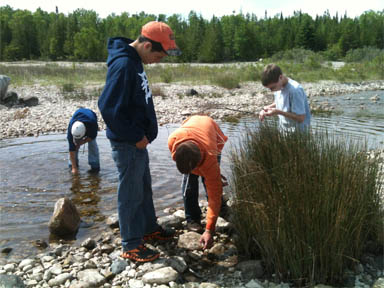Rogers City students explore, write about endangered species in Thompson’s Harbor State Park
Learning alongside resource experts, students gain an understanding of the ecological and community values natural resources have on their community and share this information as an interpretive source for visitors to Thompson’s Harbor State Park.
Supported by Michigan Sea Grant and other community partners through the Northeast Michigan Great Lakes Stewardship Initiative (NE MI GLSI), forty-nine seventh grade students from Rogers City schools trekked the shoreline and trails of Thompson’s Harbor State Park. These budding researchers explored the diversity of coastal Lake Huron, woodland, and wetland habitats, looking for the rare threatened and endangered plants and animals found in these places. Their challenges—share what they have learned with others!
Learning alongside resource experts from the Michigan Department of Natural Resources (DNR), Friends of Thompson’s Harbor State Park, Michigan Sea Grant, and Huron Pines AmeriCorps, students experienced bogs, fens, and other woodland habitats within the park while learning about park history and management with DNR Parks staff. “What I liked about doing the project,” said Brady Hill, a seventh-grader, “was that you got to explore a new animal, figure out what it does, find out a little bit more about it and learn how to protect it.”
As part of a blended learning experience, students learned
about the ecological and community values of the local natural resources, and
then selected a rare species found in Presque Isle  County to research and write
a report. Among the many species found in the county, students highlighted the
federally protected Dwarf Lake Iris, Pitcher’s Thistle, Hine’s Emerald
Dragonfly and Eastern Massasauga Rattlesnake. Students applied their science
and writing skills to compile their research findings into a report for each
species. The completed research booklets include photos, status and ecological
information about the threatened or endangered species they studied. To make
these resources available to a wider audience, some of the student booklets
will find a home in each of the park’s two cabins. This field trip “was a
unique experience to actually go out in the field and see the species that
students researched and wrote about in their reports,” says Holly Wirgau,
seventh-grade science teacher.
County to research and write
a report. Among the many species found in the county, students highlighted the
federally protected Dwarf Lake Iris, Pitcher’s Thistle, Hine’s Emerald
Dragonfly and Eastern Massasauga Rattlesnake. Students applied their science
and writing skills to compile their research findings into a report for each
species. The completed research booklets include photos, status and ecological
information about the threatened or endangered species they studied. To make
these resources available to a wider audience, some of the student booklets
will find a home in each of the park’s two cabins. This field trip “was a
unique experience to actually go out in the field and see the species that
students researched and wrote about in their reports,” says Holly Wirgau,
seventh-grade science teacher.
Michigan Sea Grant coordinated with Rogers City School and project partners to launch this student-led project, sharing Michigan Natural Features Inventory data and informational resources about the rare species of plants and animals found locally in Presque Isle County. In their studies, students discovered that conservation of these local resources are critical in protecting ecological diversity across Lake Huron and throughout the Great Lakes, as identified in the Lake Huron Biodiversity Conservation Planning Report. Through Department of Natural Resources management planning reports, students learned about the need for increased awareness and education in helping to promote and protect the rare habitats, plants, and animals of Thompson’s Harbor State Park.
Students discovered that conservation of these local resources is critical in protecting ecological diversity across Lake Huron and throughout the Great Lakes. They also learned about the need for increased awareness and education in helping to promote and protect the rare habitats,plants, and animals of Thompson’s Harbor State Park.
Through this student project, protecting biodiversity and growing coastal tourism come together in a creative and sustainable way. Northeast Michigan communities value and recognize that these amazing and rare coastal resources can also, if protected, serve as an economic development opportunity through tourism. Ecotourism offers an opportunity to attract visitors with an interest in experiencing, but also protecting, these natural areas. A Sea Grant-sponsored research effort recently focused on sustainable coastal tourism development in the region, identifying education and resource interpretation as a key need in advancing sustainable coastal tourism in the region. This need and opportunity to provide interpretation and education about local resources is echoed, alike, by regional tourism partnerships, such as the U.S. 23 Heritage Route, and resource management agencies with a mutual goal of promoting resources as an avenue of protecting them.


 Print
Print Email
Email


